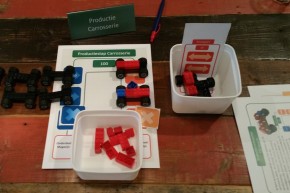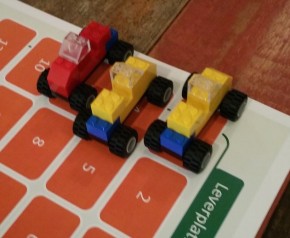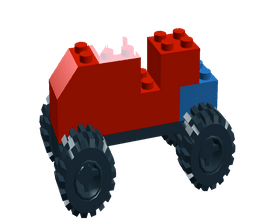This quick blog describes the CarWorks Gamification.
CarWorks is a car factory that wants to deliver value to their customers. At this very moment, the performance is bad and the profit is under pressure. Time for a serious performance improvement to make the company healthy again!
Setup
The setting was based on the CarWorks business simulation.
The team acts in different roles. The production team, the sales manager, the director and the procurement manager. All playing an important role in this team.
The team starts with preparation. They all read their roles and try to understand what their tasks and responsibilities are. In fact this is the first learning experience. They realize if this is unclear at the start of the simulation, it will hurt later on

during the day. Then the Sales Manager comes in and introduce his first deal!. Ten red cars for his customer. It could bring a lot of business.
The team starts to prepare the process, share the requirements and order the components.

After 20 minutes the production process starts. After a few minutes, there is a serious problem in the process. Problems with the transport, waiting time, too much stock etc.
During reflection the team learns the TIMWOODS principles.
Transport, Inventory, Movement, Waiting, Over Production, Over Processing, Defects and Skills.
The team feels the frustration and we discuss how to avoid this. During this exercises we practice the ANDON and KAIZEN principle. We teach the team to find the ROOT CAUSE of this situation. Then we discuss how to IMPROVE the performance by using KATA. The team defines the small steps to improve the work.
Then the next order comes in and it’s time to prepare the next cycle. The team starts with a DAY START session. They agree on the improvements and how to avoid the mistakes and how to deliver more value to the customer.

The next round was much better, 8 cars were produced and CarWorks made some first profit. But unfortunately one of the customers was not happy. He asked for a Spoiler on his car and he did not receive it. The team discovered how important The Voice of the Customer is. This is crucial to create value for your customer.
During the Improvement Cycle some other items were discovered.
- If we want to take over each others work, we need to use the 3:1 1:3 principle. 3 people should be able to perform 1 task and 1 task must be executed by 3 people.
- We need to be careful planning all our capacity. The 10 cars we planned took all our capacity. We should keep a 90% threshold so we can deal with sudden issues. For the last round, this became very important since we received lot’s of small deals since the customer was not ordering large packages but small packages to be able to deliver JUST IN TIME.
- The team was able to increase the value of the ADDED VALUE activities, they learned how to remove the NON ADDED VALUE activities and they learned how to deal with the NECESSARY NON ADDED VALUE items.
- During the day the customer became more and more demanding. This means that the process needed to be more and more Agile and Flexible.
What can we learn from this exercise for our LEAN
IT Simulation?
- We need to UNDERSTAND the LEAN principles in order to be able to translate them to IT processes and day to day work. It’s not enough to KNOW what LEAN is.
- We need to be able to RECOGNIZE the improvement opportunities in our IT environment. If we understand the LEAN principles, we can start recognizing them and take actions.
- We need to focus on creating VALUE and NOT saving COSTS. This cannot work together. FIRST value, then costs.
- If processes do not work effective, or do not bring value, we MUST find the ROOT CAUSE before we continue. This requires an professional attitude from each of the stakeholders. It’s not about the question WHO did it wrong, but WHERE did it went wrong. Then we can create an HEALTHY environment for Improving processes.
- KAIZEN and KATA are important principles to practice in the CSI circle. SMALL steps to a high performing team within a KAIZEN approach.
- We need to work with the NON ADDED VALUE activities. Which actions we take do not bring VALUE to our service. We need to remove them. And we must learn not to spent too much time on the Necessary Non Added Value items. These are facts and we have to find ways to learn with this. If we do not have the most effective tool, find ways to work with it.
Participant Feedback
In this 5 hours workshop, ALL LEAN principles came by and gave me a total picture of the essence of LEAN
It was really important to PRACTICE in this realistic environment. I realize that it’s not easy to USE the principles in your day to work. But….. DOING it will bring the real value.
For me the link from this exercise to many ITSM processes are now easy to make. I recognized lot’s of improvement opportunities.
If you would like to play the CarWorks business simulation, contact us info@wordpress-129153-2119642.cloudwaysapps.com





